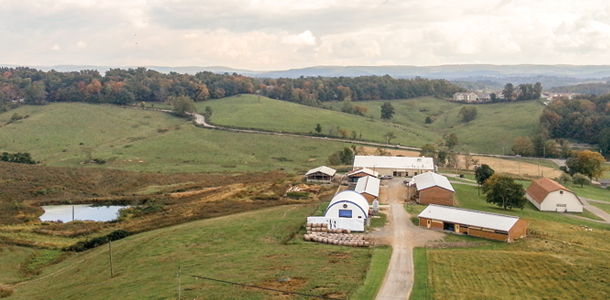He’s taken an active role in managing the university’s beef herd to make sure calves are off to a great start from day one through the time they leave the farm.
A great start begins with a solid calf feeding program, and West Virginia University’s feeding program has resulted in an average daily gain of nearly 5 pounds per day.

“It all started a few years ago when we wanted to do a calf feeding trial using complete and semi-complete feeds at the farm,” says Reed, who was in charge of the trial.
“I was skeptical at first. The university’s calves had not been creep-fed – they never saw grain. They were used to eating grass with their dams.”
The results impressed Reed, who converted all of the university’s calves and his own personal calf herd to a complete starter program.
“I was absolutely amazed at how quickly calves started eating grain. There was never a lull period. They went to it and started eating and growing,” explains Reed. “We saw results on the complete feed treatment that were at nearly 5 pounds per day average daily gain. That was pretty outstanding.”
The university herds consist of purebred Hereford and Angus cattle, as well as a commercial group, totaling more than 200 head. The herds typically calve in February and wean in September at around 500 pounds or 6 months old.
“Ever since the trial, we’ve been providing our calves a complete feed for the first 21 to 28 days post-weaning. After that, we start transitioning them to the diet they receive through the growth stage, which consists of a total mixed ration of corn silage, corn and soybean meal premix, and some sorghum-sudan or alfalfa,” says Reed.
Reed also attributes a quality animal health protocol to the university’s weaning-time success. All of the Hereford calves get a fly control ear tag to help control pinkeye, and they have a top-notch vaccination protocol, based in part on the bull test sale they manage each year.
Aside from the university’s bulls being sold through the bull test, they keep all heifers from the Hereford and Angus herds for classroom purposes. Bulls that don’t go to test are castrated and put into a trailer load for a feedlot.
Taking home results
The results Reed saw with the university herd convinced him to implement a similar program on his family’s farm in Mount Storm, West Virginia, where they raise commercial cattle as well as purebred registered Angus.
“Since working with the university trial, we’ve been using a complete feed at home, fed for 28 days post-weaning,” says Reed. “After that period, I start transitioning the bulls and replacement heifers we plan to keep onto a silage-based diet consisting of corn silage and hay. We also top-dress with a commodity pellet for additional protein.”
Reed reports seeing a 4-pound per-day average daily gain on his own calves, and buyers have taken notice.
“The feedlot purchaser who buys our home-raised animals is extremely happy with the fact that the calves are bunk-broke, eating and ready to roll in a feedlot situation,” adds Reed.
With both the university and home herds, Reed focuses on making the weaning period a smooth transition.
“You have to focus on stress reduction during the weaning period because it impacts their immune systems,” says Reed. “Nutrition has been one tool we’ve used to help get calves through that stressful period.
“Our calves are attracted to the feed, which gets them eating quickly. Because they’re eating, they don’t get stressed, which is our ultimate goal.
“We absolutely don’t want to see calves going backward and losing weight during the transition period, and getting them eating a complete feed has really helped smooth the transition and help those calves gain weight.”
On Reed’s home operation, heifers that aren’t used as replacements are sold, and bulls move to a feedlot.
Sharing nutrition insights
Reed shares that his top nutritional advice is, “There’s no one-size-fits-all program.”
“What I do on my personal farm is a little different from what we do at the university, as our end goals are slightly different.
Regardless, if you focus in on where you want your calves to go, your nutrition program should follow suit – whether it’s getting calves prepared to go to a seedstock operation or putting weight on calves for a feedlot,” says Reed.
“No matter where your calves go, their future success is dependent upon a successful weaning transition and nutrition program,” he adds.
“Using a high-quality complete feed for weaning calves can help them tremendously. There is simply no transition period. They get on feed and start growing,” says Reed. “That’s what I’ve learned in the two years since we’ve been on it.”
For replacements, Reed believes that a quality starting program sets those calves up for success as cows.
“I’m in 100 percent agreement that calf nutrition plays a role in the future success of the herd. It really sets them up to move from one life stage to the next – from weaning time to breeding time to calving and beyond,” says Reed. ![]()
Kayla Jentz is a media relations executive at Filament Marketing, based out of Madison, Wisconsin.
PHOTO 1: A mixed ration awaits Robert Reed’s calves in the first weeks after weaning.
PHOTO 2: An aerial shot from the West Virginia University Animal Science Farm located in Morgantown, which has 40 head of purebred Herefords. Photos courtesy of Robert Reed.





